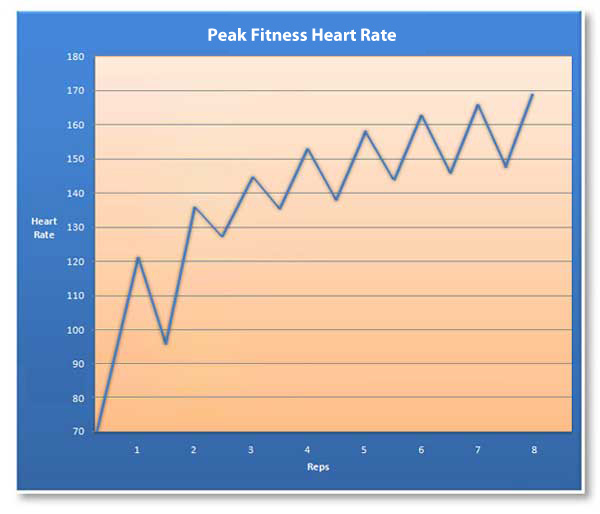Here is a rundown of what a typical interval training routine might look like at the intermediate level. This can be completed within 20 to 25 minutes:
Warm up for three minutes.
Exercise as hard and fast as you can for 30 seconds. Ideally, you should push yourself to "failure" — this is the part of the exercise where you can no longer maintain good form, but still be able to perform another repetition.
When you reach failure, it would be very difficult, if not impossible, for you to continue the exercise for another 10 seconds, as you just don't have that much oxygen left to contract your muscles.
You should be gasping for breath and feel like you couldn't possibly go on another few seconds. It is better to use lower resistance and higher repetitions to increase your heart rate.
Recover for 90 seconds, still moving, but at slower pace and decreased resistance.
- Repeat the high-intensity exercise and recovery up to seven more times. However, at this level, you will likely only be doing four to six. As you get fitter, just keep adding repetitions gradually until you're doing eight during your 20-minute session. Remember never to do these exercises more than three times a week or you will compromise your recovery.
You might feel sore 24 hours after you perform Peak Fitness. To help your body recover properly, you should:
- Do some light stretching
- Drink plenty of water
- Get enough sleep
- Eat small, healthful meals throughout the day
Using an Elliptical Trainer
When you do Peak Fitness exercises, you can make use of a recumbent bike, treadmill, or elliptical. You can even try swimming or sprinting outdoors (be extra careful when doing this to avoid injury).
Personally, I believe that using a treadmill for Peak Fitness exercises is not the best idea. Treadmills can take time to adjust intensities.1 Instead of being able to exercise intensely for 30 seconds, it may only be 20 seconds. The elliptical machine is the best equipment for Peak Fitness. Fitness expert Phil Campbell, creator of Sprint 8 exercises (the inspiration for Peak Fitness), says that using an elliptical machine leads to a higher release of growth hormone.
He also notes that an elliptical is the most challenging equipment to use.2 For a demonstration of a Peak Fitness routine using an elliptical trainer, watch this video.
Choosing the Right Elliptical Trainer
Elliptical trainers are the fitness world's most recent innovations, as they combine the best features of other exercise machines. There are various types of these machines out in the market. I advise you to find one that has support bars that will allow you to experience a type of cross training where you work your upper body together with your lower body. Using elliptical trainers can yield numerous benefits. With their moving support bars, elliptical trainers can:
- Provide a workout with lower intensity than treadmills, as they cause less pounding and stress on your ankles, knees, and hip joints
- Enable you to achieve an efficient total body and cardio workout, including your upper body and your major muscle groups
- Allow you to work out using a natural motion stride that simulates walking or jogging
For you to balance quality and value when shopping for an elliptical machine, here are some factors to consider:
- Can it accommodate the weight of everyone in the household? A quality machine can accommodate individuals weighing up to 350 to 400 pounds.
- What type of bearing does the machine have? I suggest finding a machine with self-aligning sealed ball bearing at the pivot points, since these do not require any lubrication.
- Do the foot pedals allow your feet to remain flat throughout the workout? This helps keep the pressure evenly distributed throughout your entire foot.
- Can the machine handle the pressure of high-intensity exercise? Avoid smaller and lighter weight elliptical trainers; get ones that are designed for high-intensity exercises.
- Can you make adjustments to the elliptical machine to target a specific muscle group?
- Does the machine have a natural stride and foot path, and does it ensure proper posture and range of motion?
- Does the machine offer variety? The machine should enable you to vary resistance, speed, incline, and intensity. More importantly, it should be programmed for different exercise programs, like Peak Fitness.
- Does it have a built-in heart rate monitor? I'll explain in the next section why this is important.
Using a Heart Rate Monitor
To give you an idea of how your heart rate will "peak" during interval cycles, here's a chart showing you the status of my heart rate while doing Peak Fitness on a recumbent bike.

Fig. 3 — My heart rate while doing Peak Fitness on a recumbent bike
Accuracy is key in Peak Fitness exercises, because there is, for example, a huge difference between 166 and 168 beats per minute. It is impossible to count this manually if your heart rates have exceeded 127 to 175 beats per minute — and especially difficult when you're out of breath!
I strongly suggest investing in a chest strap heart rate monitor to determine if you're working with the right intensity. You're on the right track if you exceed your maximum heart rate (which is 220 minus your age) by five or 10 beats. When you've reached your maximum heart rate, you may feel lightheaded and/or very short of breath. Nevertheless, in about 30 to 60 seconds, your body will catch up with you and you'll be back to normal.